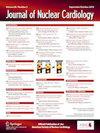心率压积校正心肌血流储备的预后意义。
IF 3
4区 医学
Q2 CARDIAC & CARDIOVASCULAR SYSTEMS
引用次数: 0
摘要
背景:目前尚不清楚心率压积(RPP)校正后的心肌血流储备(MFR)与未校正的心肌血流储备(MFR)一起是否会导致分层事件。在本研究中,我们评估了一致性与不一致性、纠正与未纠正的MFR与事件结局之间的关系。方法:在前瞻性登记中,连续患者接受临床指示的正电子发射断层扫描。MFR以应激与静息心肌血流量之比计算,并以RPP (MFRcorr)校正。一致性MFR组定义为MFR≥2- mfrcorr≥2和MFR结果:研究人群包括4564例患者,平均(SD)年龄66(12)岁,女性56%,白人60%,黑人24%。与MFR≥2- mfrcorr≥2的患者相比,MFR≥2- mfrcorr的主要结局风险增加本文章由计算机程序翻译,如有差异,请以英文原文为准。

The prognostic significance of rate pressure product corrected myocardial flow reserve
Background
It is unknown whether myocardial flow reserve (MFR) corrected for rate pressure product (RPP) can risk stratify events when added to uncorrected MFR. In this study, we evaluated the relationship between concordant vs discordant corrected and uncorrected MFR and incident outcomes.
Methods
Consecutive patients referred for clinically indicated positron emission tomography were enrolled in a prospective registry. MFR was calculated as the ratio of stress to rest myocardial blood flow and corrected for RPP (MFRcorr). Concordant MFR groups were defined as MFR ≥2-MFRcorr ≥2 and MFR <2-MFRcorr <2, while discordant MFR groups were defined as MFR ≥2-MFRcorr <2 and MFR <2-MFRcorr ≥2. The primary outcome was a composite of myocardial infarction, late revascularization and death.
Results
The study population included 4564 patients, mean (SD) age 66 (12) years, 56% females, 60% White and 24% Black. Compared with patients with MFR ≥2-MFRcorr ≥2, there was an increase in risk of the primary outcome in those with MFR ≥2-MFRcorr <2 [hazard ratio (95% confidence interval)]: 1.59 (.98, 2.57; P = .061), MFR <2-MFRcorr ≥2:2.16 (1.50, 3.11; P < .001) and MFR <2-MFRcorr <2:2.91 (2.13, 3.98; P < .001).
Conclusions
MFR <2 is associated with a higher risk of cardiovascular outcomes and death even if corrected MFR is ≥2.
求助全文
通过发布文献求助,成功后即可免费获取论文全文。
去求助
来源期刊
CiteScore
5.30
自引率
20.80%
发文量
249
审稿时长
4-8 weeks
期刊介绍:
Journal of Nuclear Cardiology is the only journal in the world devoted to this dynamic and growing subspecialty. Physicians and technologists value the Journal not only for its peer-reviewed articles, but also for its timely discussions about the current and future role of nuclear cardiology. Original articles address all aspects of nuclear cardiology, including interpretation, diagnosis, imaging equipment, and use of radiopharmaceuticals. As the official publication of the American Society of Nuclear Cardiology, the Journal also brings readers the latest information emerging from the Society''s task forces and publishes guidelines and position papers as they are adopted.

 求助内容:
求助内容: 应助结果提醒方式:
应助结果提醒方式:


